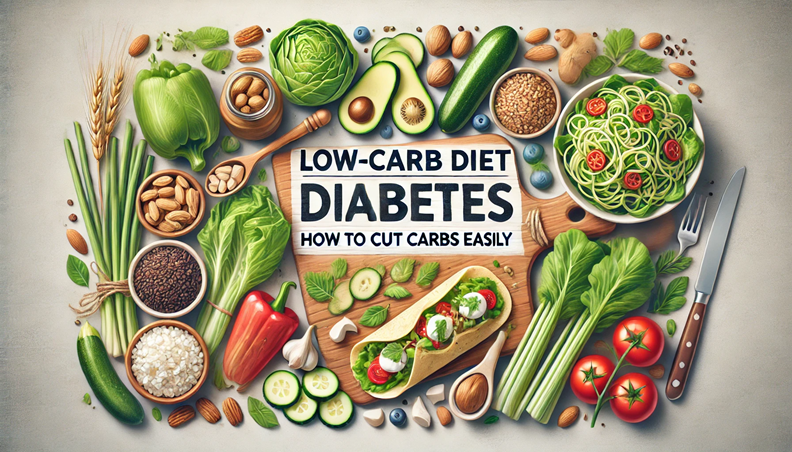Low-Carb Diet and Diabetes: How to Cut Carbs Easily

A low-carb diet can be an effective approach to managing diabetes, providing benefits like improved blood sugar control, insulin sensitivity, and potential weight loss. However, it’s important to understand how to cut carbs safely and effectively to achieve these results. This guide will cover frequently asked questions about low-carb diets for diabetes and provide tips for incorporating this approach into your daily routine.
Table of Contents
Is a Low-Carb Diet Good for a Diabetic?
Reducing carbohydrate intake can help diabetics manage blood sugar levels by minimizing glucose spikes after meals. Studies show that a low-carb diet can help reduce HbA1c levels, stabilize energy, and decrease cravings, making it easier to manage diabetes. However, every person’s needs differ, so consulting a healthcare professional is essential.
- Benefits of a Low-Carb Diet for Diabetes
- Lower HbA1c levels
- More stable blood sugar levels
- Reduced cravings for high-carb foods
- Potential Risks and Considerations
- Type 1 diabetics may need to adjust insulin doses.
- Nutritional balance is essential; low-carb doesn’t mean low-nutrient.

What is the 15-Carb Rule for Diabetes?
The « 15-carb rule » helps diabetics manage hypoglycemia (low blood sugar). Consuming 15 grams of carbs can raise blood sugar levels quickly. This simple approach helps diabetics avoid dangerous lows without disrupting a low-carb diet.
- H3: Understanding the 15-Carb Rule for Hypoglycemia
- For hypoglycemia, eat 15 grams of carbs (e.g., juice, glucose tablets).
- Check blood sugar after 15 minutes and repeat if necessary.
What Happens if a Diabetic Doesn’t Eat Enough Carbs?
Consuming too few carbs can lead to low blood sugar (hypoglycemia), fatigue, and nutrient deficiencies. Diabetics should monitor for signs like dizziness, fatigue, and difficulty concentrating if their carb intake drops too low.
- H3: Signs of Not Eating Enough Carbs for Diabetics
- Fatigue, dizziness, and low energy
- Increased risk of hypoglycemia
- H3: Adjusting Carb Intake Safely
- Introduce more low-glycemic carbs as needed.
- Work with a healthcare provider to monitor blood sugar.
Why is My Blood Sugar High If I Eat No Carbs?
Some diabetics notice high blood sugar even with a low-carb diet. This can occur due to hormones like cortisol or adrenaline, protein intake, or other factors such as stress or illness. Monitoring these variables can help you understand what might be affecting your blood sugar.
- Factors Affecting Blood Sugar Beyond Carbs
- Stress hormones (like cortisol) can increase blood sugar.
- High protein intake may also impact blood sugar in certain diabetics.
Low-Carb Diet for Diabetes Type 2
A low-carb diet can benefit type 2 diabetics by reducing blood sugar fluctuations and potentially reversing insulin resistance. For type 2 diabetics, sticking to low-glycemic foods like leafy greens, lean proteins, and healthy fats can improve long-term blood sugar control.
- How a Low-Carb Diet Helps Type 2 Diabetes
- Reduces post-meal blood sugar spikes
- Can support weight loss and reduce insulin resistance
- Tips for Sticking to a Low-Carb Diet with Type 2 Diabetes
- Focus on fiber-rich foods like non-starchy vegetables.
- Meal-prep to avoid high-carb temptations.
Low-Carb Diet for Diabetes Type 1
Type 1 diabetics can benefit from a low-carb diet, but it requires careful monitoring and insulin adjustments. Since the body’s insulin needs change with carb intake, type 1 diabetics should work with their healthcare team when making dietary changes.
- Benefits and Challenges of Low-Carb for Type 1 Diabetes
- Improved blood sugar control with fewer highs and lows
- Requires close monitoring to avoid hypoglycemia
- Practical Tips for Type 1 Diabetics on a Low-Carb Diet
- Regularly check blood sugar and adjust insulin doses.
- Plan meals carefully, balancing protein, fat, and carbs.
List of Good Carbs for Diabetics
Including low-glycemic carbs in a diabetes-friendly diet is essential for energy and balance. Foods like leafy greens, berries, and whole grains provide fiber without spiking blood sugar.
- Best Low-Glycemic Carbs for Diabetes Management
- Leafy greens (spinach, kale)
- Berries (strawberries, blueberries)
- Whole grains (quinoa, barley)
- High-Fiber Foods for Better Blood Sugar Control
- Fiber slows carb digestion, leading to steadier blood sugar levels.
- Options include legumes, chia seeds, and non-starchy vegetables.
Conclusion
A low-carb diet can be an effective tool for managing diabetes, improving blood sugar stability, reducing cravings, and supporting long-term health. By gradually reducing high-carb foods, tracking carb intake, and consulting with a healthcare provider, diabetics can achieve better blood sugar control while enjoying a balanced diet. Making informed choices and focusing on nutrient-rich, low-glycemic foods can make this dietary change sustainable and beneficial.
FAQ – Common Questions on Low-Carb and Diabetes
Can a low-carb diet cure diabetes?
No, but it can help manage blood sugar and reduce dependence on medication, especially for type 2 diabetes.
How quickly does a low-carb diet affect blood sugar?
Some people notice improvements in blood sugar within weeks. Effects can vary based on individual health and carb reduction.
Is fruit allowed on a low-carb diet for diabetes?
Yes, but stick to low-sugar fruits like berries and monitor portions to avoid spikes.
Do I need to track calories on a low-carb diet?
While tracking calories isn’t essential, monitoring carbs is recommended for blood sugar control. Calorie tracking can also support weight management.
Useful Links
- American Diabetes Association: Resources on diabetes management and diet.
- Centers for Disease Control and Prevention (CDC): Tips for healthy eating with diabetes.
- National Institute of Diabetes and Digestive and Kidney Diseases (NIDDK): Guidance on low-carb diets for diabetes.






